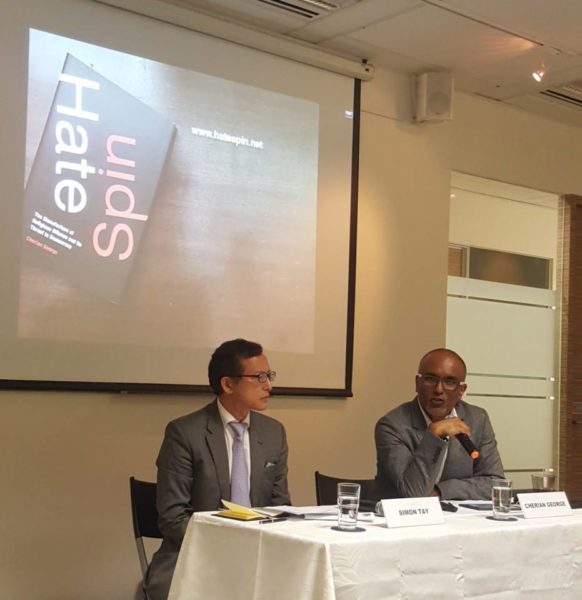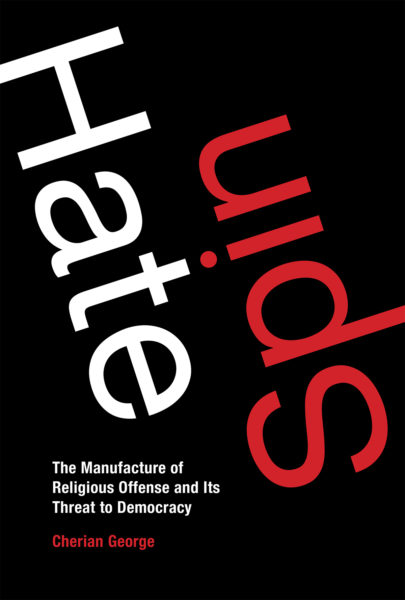In multi-religious, multiracial Singapore, many Singaporeans will not hesitate to stand up on behalf of countrymen at the receiving end of racist jokes, insults and discrimination. From young, Singaporeans have been taught the importance of respecting different religions and cultural practices. Where public education is insufficient, the government has an array of legal tools to tackle instigators of religious and racial conflict.
So far, so good. The Singapore society is stable and prosperous. The various religious and racial communities live in harmony. But beyond Singapore’s shores, a new phenomenon is taking place in many democratic societies that will threaten the city-state’s secularism and tolerance: hate spin. In India, Indonesia and the United States, this new phenomenon has exploited democratic freedoms to silence critics and spread intolerance.
Dr Cherian George coined the term “hate spin” in his latest book: Hate Spin: The Manufacture of Religious Offense and its Threat to Democracy. The Singapore-born and Hong Kong-based academic defined hate spin as a technique of contentious politics that involves the strategic use of offense-giving and offense-taking. Hate spin exploits democratic freedoms by harnessing group identities as a resource to attack and silence others.
Photo: Dr Cherian George (right) speaking in Singapore on Jan 17, 2017, at the invitation of the Singapore Institute of International Affairs. Associate Professor Simon Tay (left), moderated the dialogue. Photo credit: Mohamed Imran Mohamed Taib’s blog.
In his book, Cherian devotes much effort to explaining how hate spin differs from hate speech. Hate speech, already quite a well-known problem in many diverse societies, spreads extremely negative ideas about a group and usually targets vulnerable minorities along the lines of race, religion and sexual orientation. In contrast, hate spin deliberately manufactures indignation while masking itself in victimhood.
(Click here to read our post-event discussion about hate spin to Singapore’s context)
What are the key features of hate spin? Cherian suggests some tell-tale signs:
- Sustained and sensational angry reactions towards perceived provocations.
- Inconsistency of offense-taking, such as time lags between the appearance of an offending work and the first outbreak of outrage against it.
- Spin doctors and ‘institutionalized riot systems’ which manufactures the indignation to mobilise followers for a political goal.
Why do people engage in hate spin? One possible reason is that political leaders, struggling to maintain economic growth, utilise hate spin and a versatile tool to boost support. Unlike economic reality which is hard to bend, religious offendedness can be manufactured out of thin air. Hate spins usually have a strategic intent, an aim to gain mileage from the process of offense-taking, regardless of whether the protest’s short-term goal succeeds.
Photo: Hate Spin is available for sale at bookstores around Singapore. The Humanist Society (Singapore) strongly recommends the book.
In his book: Cherian lists some examples of hate spin:
• The Satanic Verses was written by Salman Rushdie and published in 1988. Tensions surrounding the book was escalated by Iranian supreme leader Ayatollah Khomeini into a global clash of values. He issued an edict ordering the death of Rushdie and his editors. Khomeini was seeking to revive internal support for the Islamic Republic after a devastating eight-year war with Iraq.
• A sculpture, “Three Beauties” by Balinese artist Nyoman Nuarta, depicted 3 women in traditional Sundanese dress. For 3 years, it graced the front of an upmarket residential complex in Indonesia. In early 2010, Islamists argued that the sculpture is a Christian provocation. This led to mass demonstrations and a petition to remove the sculpture.
• A mosque was going to be built at Lower Manhattan near the ground zero of the Sept 11 attacks. However, anti-Muslim spin agents had spread extreme allegations against the mosque, leading to protests against it. This took place even though there was already another mosque at Warren Street, near the site of the new mosque, for a long time.
Towards the end of his book, Dr Cherian George called for “assertive pluralism” to protect 1) liberty, including the freedom to share provocative ideas, and 2) equality, including the capacity to take part in public life unhindered by unfair discrimination or intimidation. Both are key pillars in democratic and free societies. Under assertive pluralism:
- Leaders of democracies defend to death their citizens’ right to speak and proclaim their vigorous disagreement with speech that promotes intolerance.
- A legal framework and system is made compatible with the reality of diversity where blood and belonging cannot outrank law.
- A constitutional order compatible with modern human rights, protecting the fundamental civil and political rights of every individual.
- Courageous and charismatic leaders prying open people’s minds to the possibility of unity in diversity, accompanied by constant renewal and institutionalization.







